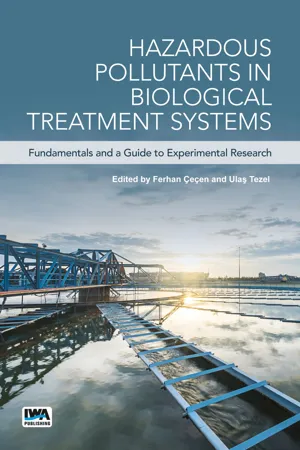
Hazardous Pollutants in Biological Treatment Systems
Fundamentals and a Guide to Experimental Research
- 400 pages
- English
- ePUB (mobile friendly)
- Available on iOS & Android
Hazardous Pollutants in Biological Treatment Systems
Fundamentals and a Guide to Experimental Research
About this book
Hazardous pollutants are a growing concern in treatment engineering. In the past, biological treatment was mainly used for the removal of bulk organic matter and the nutrients nitrogen and phosphorus. However, relatively recently the issue of hazardous pollutants, which are present at very low concentrations in wastewaters and waters but are very harmful to both ecosystems and humans, is becoming increasingly important. Today, treatment of hazardous pollutants in the water environment becomes a challenge as the water quality standards become stricter. Hazardous Pollutants in Biological Treatment Systems focuses entirely on the hazardous pollutants present in wastewater and water and gives an elaborate insight into their fate and effects during biological treatment.
Currently, in commercial and industrial products and processes, thousands of chemicals are used that reach water. Many of those chemicals are carcinogens, mutagens, endocrine disruptors and toxicants. Therefore, water containing hazardous pollutants should be treated before discharged to the environment or consumed by humans.
This book first addresses the characteristics, occurrence and origin of hazardous organic and inorganic pollutants. Then, it concentrates on the fate and effects of these pollutants in biological wastewater and drinking water treatment units. It also provides details about analysis of hazardous pollutants, experimental methodologies, computational tools used to assist experiments, evaluation of experimental data and examination of microbial ecology by molecular microbiology and genetic tools.
Hazardous Pollutants in Biological Treatment Systems is an essential resource to the researcher or the practitioner who is already involved with hazardous pollutants and biological processes or intending to do so. The text will also be useful for professionals working in the field of water and wastewater treatment.
Frequently asked questions
- Essential is ideal for learners and professionals who enjoy exploring a wide range of subjects. Access the Essential Library with 800,000+ trusted titles and best-sellers across business, personal growth, and the humanities. Includes unlimited reading time and Standard Read Aloud voice.
- Complete: Perfect for advanced learners and researchers needing full, unrestricted access. Unlock 1.4M+ books across hundreds of subjects, including academic and specialized titles. The Complete Plan also includes advanced features like Premium Read Aloud and Research Assistant.
Please note we cannot support devices running on iOS 13 and Android 7 or earlier. Learn more about using the app.
Information
Table of contents
- Cover
- Half Title
- Title Page
- Copyright Page
- Contents
- About the Editors
- Chapter 1: A guide book to studying the fate and effect of hazardous pollutants in biological treatment systems
- Chapter 2: Hazardous pollutants in the water environment
- Chapter 3: Quantification of hazardous pollutants in biological systems
- Chapter 4: Removal and behavior of hazardous pollutants in biological treatment systems
- Chapter 5: Experimental assessment of the inhibitory effect and biodegradation of hazardous pollutants
- Chapter 6: Removal of hazardous pollutants in full-scale wastewater treatment plants
- Chapter 7: Integrating microbial and molecular tools to determine the fate and impact of hazardous pollutants
- Chapter 8: Biological removal of hazardous pollutants in drinking water treatment
- Chapter 9: Future aspects of hazardous pollutants and their biological removal
- Index